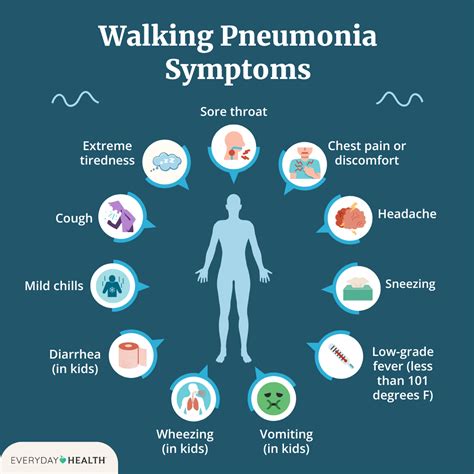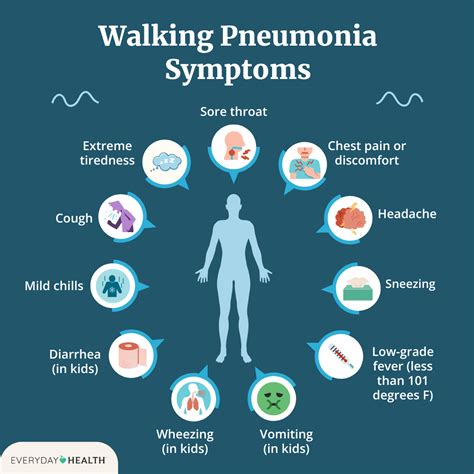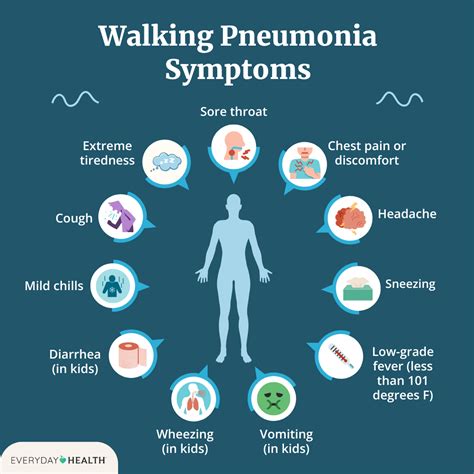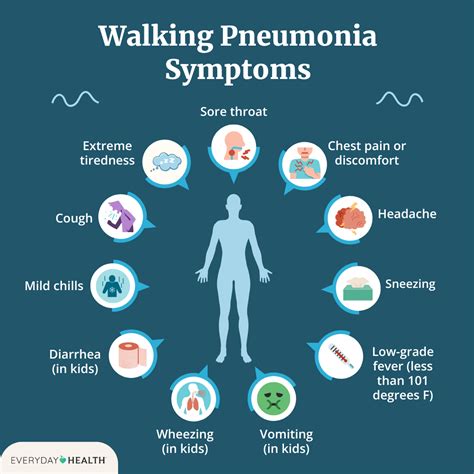Intro
Discover how walking pneumonia occurs through 5 common ways, including viral infections, bacterial exposure, and weakened immune systems, to understand symptoms and prevention methods for this mild yet contagious respiratory illness.
Walking pneumonia, also known as atypical pneumonia, is a type of pneumonia that is not caused by the traditional bacteria that typically cause pneumonia. Instead, it is often caused by mycoplasma pneumoniae, a type of bacteria that is usually mild and can be treated with antibiotics. Walking pneumonia is called as such because its symptoms are often mild enough that one can still be walking around and going about their daily activities, rather than being bedridden. In this article, we will explore the 5 ways walking pneumonia occurs, as well as its symptoms, diagnosis, treatment, and prevention.
The importance of understanding walking pneumonia cannot be overstated. It is a common illness that can affect anyone, regardless of age or health status. In fact, according to the American Lung Association, walking pneumonia is one of the most common types of pneumonia, accounting for up to 20% of all pneumonia cases. Furthermore, if left untreated, walking pneumonia can lead to more serious complications, such as bronchitis, sinusitis, and even meningitis. Therefore, it is crucial to recognize the signs and symptoms of walking pneumonia and seek medical attention if necessary.
Walking pneumonia can occur in anyone, but it is most common in school-aged children and young adults. The exact cause of walking pneumonia is not always known, but it is often spread through respiratory droplets, such as those produced by coughing or sneezing. In addition, walking pneumonia can be caused by a variety of factors, including viral infections, bacterial infections, and environmental factors. In the following sections, we will delve into the 5 ways walking pneumonia occurs, including the role of mycoplasma pneumoniae, the importance of respiratory droplets, and the impact of environmental factors.
What is Walking Pneumonia?

Causes of Walking Pneumonia
Walking pneumonia can be caused by a variety of factors, including: * Mycoplasma pneumoniae: This is the most common cause of walking pneumonia, accounting for up to 50% of all cases. * Viral infections: Viruses such as influenza, respiratory syncytial virus (RSV), and adenovirus can also cause walking pneumonia. * Bacterial infections: Bacteria such as legionella, chlamydia, and coxiella can also cause walking pneumonia. * Environmental factors: Exposure to pollution, smoke, and other environmental toxins can increase the risk of developing walking pneumonia.5 Ways Walking Pneumonia Occurs

Symptoms of Walking Pneumonia
The symptoms of walking pneumonia can vary from person to person, but common symptoms include: * Cough * Fever * Fatigue * Headache * Sore throat * Runny nose * Body aches * Diarrhea * Nausea and vomitingDiagnosis and Treatment of Walking Pneumonia

Prevention of Walking Pneumonia
Prevention is key to reducing the risk of developing walking pneumonia. Some ways to prevent walking pneumonia include: * Practicing good hygiene, such as washing hands frequently and avoiding close contact with people who are sick * Getting vaccinated against flu and other respiratory illnesses * Avoiding smoking and secondhand smoke * Avoiding exposure to pollution and other environmental toxins * Getting enough rest and practicing stress-reducing techniques, such as meditation or yogaComplications of Walking Pneumonia

Conclusion and Next Steps
In conclusion, walking pneumonia is a common illness that can affect anyone, regardless of age or health status. Understanding the 5 ways walking pneumonia occurs can help to reduce the risk of developing the illness. By practicing good hygiene, getting vaccinated, and avoiding exposure to pollution and other environmental toxins, individuals can reduce their risk of developing walking pneumonia. If symptoms persist or worsen, it is essential to seek medical attention to prevent complications and ensure proper treatment.We invite you to share your thoughts and experiences with walking pneumonia in the comments section below. Have you or someone you know been diagnosed with walking pneumonia? What steps did you take to prevent or treat the illness? Your input can help others to better understand and manage walking pneumonia.
What is the main cause of walking pneumonia?
+The main cause of walking pneumonia is mycoplasma pneumoniae, a type of bacteria that is usually mild and can be treated with antibiotics.
How is walking pneumonia diagnosed?
+Walking pneumonia can be diagnosed through a physical examination, medical history, and laboratory tests, such as chest X-rays and blood tests.
What are the common symptoms of walking pneumonia?
+The common symptoms of walking pneumonia include cough, fever, fatigue, headache, sore throat, runny nose, body aches, diarrhea, and nausea and vomiting.
